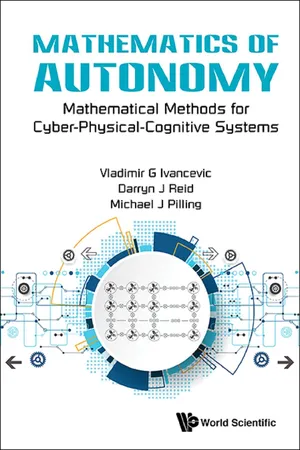
Mathematics of Autonomy
Mathematical Methods for Cyber-Physical-Cognitive Systems
Vladimir G Ivancevic, Darryn J Reid;Michael J Pilling
- 432 pages
- English
- ePUB (mobile friendly)
- Available on iOS & Android
Mathematics of Autonomy
Mathematical Methods for Cyber-Physical-Cognitive Systems
Vladimir G Ivancevic, Darryn J Reid;Michael J Pilling
About This Book
-->
Mathematics of Autonomy provides solid mathematical foundations for building useful Autonomous Systems. It clarifies what makes a system autonomous rather than simply automated, and reveals the inherent limitations of systems currently incorrectly labeled as autonomous in reference to the specific and strong uncertainty that characterizes the environments they operate in. Such complex real-world environments demand truly autonomous solutions to provide the flexibility and robustness needed to operate well within them.
This volume embraces hybrid solutions to demonstrate extending the classes of uncertainty autonomous systems can handle. In particular, it combines physical-autonomy (robots), cyber-autonomy (agents) and cognitive-autonomy (cyber and embodied cognition) to produce a rigorous subset of trusted autonomy: Cyber-Physical-Cognitive autonomy (CPC-autonomy).
The body of the book alternates between underlying theory and applications of CPC-autonomy including "Autonomous Supervision of a Swarm of Robots", "Using Wind Turbulence against a Swarm of UAVs" and "Unique Super-Dynamics for All Kinds of Robots (UAVs, UGVs, UUVs and USVs)" to illustrate how to effectively construct Autonomous Systems using this model. It avoids the wishful thinking that characterizes much discussion related to autonomy, discussing the hard limits and challenges of real autonomous systems. In so doing, it clarifies where more work is needed, and also provides a rigorous set of tools to tackle some of the problem space.
--> Contents:
- Introduction
- Physics of the CPC-Autonomy: Port-Hamiltonian Dynamics and Control of Multi-Physical Networks
- CPC-Application: Autonomous Brain-Like Supervisor for a Swarm of Robots
- Micro-Cognitive CPC-Autonomy: Quantum Computational Tensor Networks
- Cyber-Cognitive CPC-Autonomy: TensorFlow and Deep Neural Tensor Networks
- Cognitive Control in CPC-Autonomy: Perceptual Control Theory and Its Alternatives
- CPC-Application: Using Wind Turbulence against a Team of UAVs
- Cognitive Estimation in CPC-Autonomy: Recursive Bayesian Filters and FastSLAM Algorithms
- CPC Super-Dynamics for a Universal Large-Scale Autonomous Operation
- Appendix 1: The World of Tensors
- Appendix 2: Classical Neural Networks and AI
-->
--> Readership: Undergraduates, graduates and researchers in computer science, pure and applied mathematics, engineering, and physics. -->
Keywords:Autonomous Systems;Trusted Autonomy;Cyber-Physical Systems;Cognitive Systems;Port-Hamiltonian Dynamics and Control;Swarm of Robots;Brain-Like Supervisor;Deep Learning;Perceptual Control Theory;Wind Turbulence;Bayesian Estimation;FastSLAM Algorithms;Super-Dynamics;Tensors;Neural Networks;AIReview: Key Features:
- A critical examination of the unique challenges of Trusted Autonomous Systems
- Demonstrates the combination of many diverse approaches including Fuzzy Logic, Port-Hamiltonian Control Structures, Entangled-Quantum Computations, Deep Learning and Recursive Bayesian Filters and FastSLAM Algorithms
- Rigorous Mathematical Foundations including background tutorials
- Includes several solved examples
Frequently asked questions
Information
Table of contents
- Cover
- Halftitle
- Title
- Copyright
- Preface
- Acknowledgments
- Glossary of Acronyms
- Glossary of Symbols
- Contents
- 1 Introduction
- 2 Physics of the CPC-Autonomy: Port-Hamiltonian Dynamics and Control of Multi-Physical Networks
- 3 CPC-Application: Autonomous Brain-Like Supervisor for a Swarm of Robots
- 4 Micro-Cognitive CPC-Autonomy: Quantum Computational Tensor Networks
- 5 Cyber-Cognitive CPC-Autonomy: TensorFlow and Deep Neural Tensor Networks
- 6 Cognitive Control in CPC-Autonomy: Perceptual Control Theory and Its Alternatives
- 7 CPC-Application: Using Wind Turbulence against a Team of UAVs
- 8 Cognitive Estimation in CPC-Autonomy: Recursive Bayesian Filters and FastSLAM Algorithms
- 9 CPC Super-Dynamics for a Universal Large-Scale Autonomous Operation
- 10 Appendix 1: The World of Tensors
- 11 Appendix 2: Classical Neural Networks and AI
- Bibliography
- Index